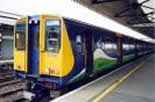Damning report issued on North London Line
"Shabby, unreliable, unsafe, overcrowded" say passengers
A report by by the Greater London Assembly Transport Committee on the North London Line has highlighted the exceptionally poor quality of this local passenger rail service. The Committee conducted a wide ranging investigation into the standard of the current service including engaging with Transport for London on their plans for the North London Railway following the transfer in November 2007. The race is on to deliver an effective service on the line in time to make it a viable route for people attending the Olympic Games in 2012.
Written by Geoff Pope, Deputy Chair of the Committee, the report states that "Passengers have expressed real discontent about the reliability and frequency of the trains, unattractive stations with poor provision for passengers, grubby and ageing rolling stock, and unsatisfactory ticketing arrangements."
The report continues, "Despite this very poor provision, both lines are well used and are often overcrowded at peak hours. Moreover, because of their orbital routes, trains are full in both directions. It is very likely that when the service and stations are made more attractive, many more people will use these lines. Stakeholders believed that the level of suppressed passenger demand was high and they submitted a large number of positive proposals to improve passenger and freight services and interchanges."
Despite some service improvements made since late 2004 by its current operator Silverlink, the trains remain in poor condition and stations are often unstaffed, which makes many passengers feel unsafe according to the report. Kensal Rise station, which is on the North London Line, was the scene of the recent murder of Tom ap Rhys Pryce, a 31 year old lawyer. The station was unattended at the time of the attack.
On 14th February 2006 the Department for Transport handed over franchising responsibilities for the NLR to the Mayor and TfL London Rail. Such responsibilities were not part of the original GLA Act in 1999. But, following the Railways Act 2005, the Mayor is beginning to realise a long held aspiration to have more direct control of London’s rail network.
The NLR will be seen as a test bed for furthering these ambitions across all London’s rail commuter routes.
The opportunity is there for TfL to set new standards as a commissioner of rail services and to provide an alternative management model for rail. Critics of the current system see it as characterised by buck passing and contractual quagmires.
TfL are promising track improvements, increased frequency of service to provide a ‘turn-up-and-go’ metro service, new rolling stock and a station upgrading programme. The NLR will play an important part in the Games’ Travel Plan of the 2012 Olympic Games and for the Paralympics. However the effective deadline for the NLR is late 2010 or early 2011. New rolling stock, signalling and track will have had to be commissioned, constructed, tested and operational to ensure that what was promised is delivered. An effective service on this line would make it the quickest transport route for many West Londoners to get to the Games. The GLA's committee have expressed scepticism that this deadline can be met
The committee made a series of recommendations including incorporating ticketing into the Oyster Pre-pay system, real time information systems and higher staff levels at stations.
March 16, 2006
